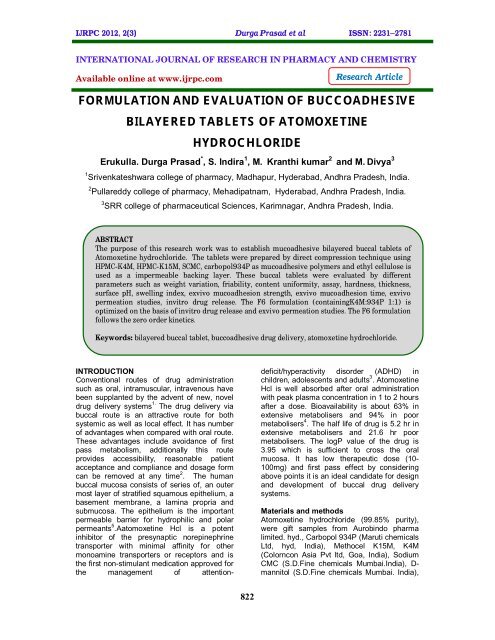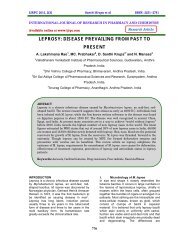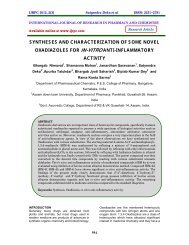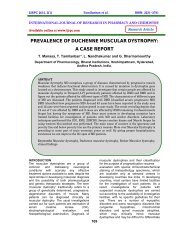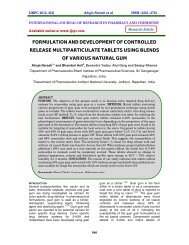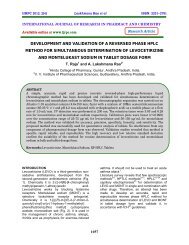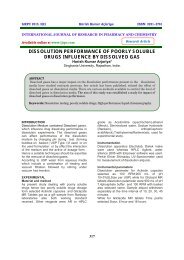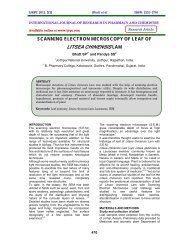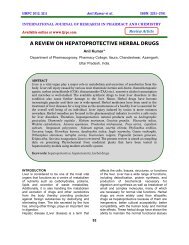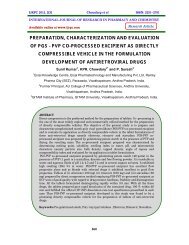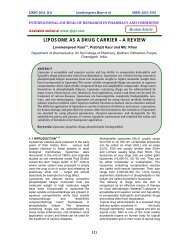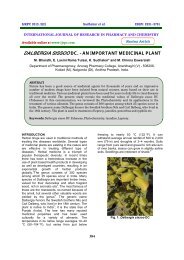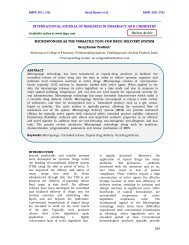formulation and evaluation of buccoadhesive bilayered tablets ... - ijrpc
formulation and evaluation of buccoadhesive bilayered tablets ... - ijrpc
formulation and evaluation of buccoadhesive bilayered tablets ... - ijrpc
You also want an ePaper? Increase the reach of your titles
YUMPU automatically turns print PDFs into web optimized ePapers that Google loves.
IJRPC 2012, 2(3) Durga Prasad et al ISSN: 22312781<br />
INTERNATIONAL JOURNAL OF RESEARCH IN PHARMACY AND CHEMISTRY<br />
Available online at www.<strong>ijrpc</strong>.com<br />
Research Article<br />
FORMULATION AND EVALUATION OF BUCCOADHESIVE<br />
BILAYERED TABLETS OF ATOMOXETINE<br />
HYDROCHLORIDE<br />
Erukulla. Durga Prasad * , S. Indira 1 , M. Kranthi kumar 2 <strong>and</strong> M. Divya 3<br />
1 Srivenkateshwara college <strong>of</strong> pharmacy, Madhapur, Hyderabad, Andhra Pradesh, India.<br />
2 Pullareddy college <strong>of</strong> pharmacy, Mehadipatnam, Hyderabad, Andhra Pradesh, India.<br />
3 SRR college <strong>of</strong> pharmaceutical Sciences, Karimnagar, Andhra Pradesh, India.<br />
ABSTRACT<br />
The purpose <strong>of</strong> this research work was to establish mucoadhesive <strong>bilayered</strong> buccal <strong>tablets</strong> <strong>of</strong><br />
Atomoxetine hydrochloride. The <strong>tablets</strong> were prepared by direct compression technique using<br />
HPMC-K4M, HPMC-K15M, SCMC, carbopol934P as mucoadhesive polymers <strong>and</strong> ethyl cellulose is<br />
used as a impermeable backing layer. These buccal <strong>tablets</strong> were evaluated by different<br />
parameters such as weight variation, friability, content uniformity, assay, hardness, thickness,<br />
surface pH, swelling index, exvivo mucoadhesion strength, exvivo mucoadhesion time, exvivo<br />
permeation studies, invitro drug release. The F6 <strong>formulation</strong> (containingK4M:934P 1:1) is<br />
optimized on the basis <strong>of</strong> invitro drug release <strong>and</strong> exvivo permeation studies. The F6 <strong>formulation</strong><br />
follows the zero order kinetics.<br />
Keywords: <strong>bilayered</strong> buccal tablet, <strong>buccoadhesive</strong> drug delivery, atomoxetine hydrochloride.<br />
INTRODUCTION<br />
Conventional routes <strong>of</strong> drug administration<br />
such as oral, intramuscular, intravenous have<br />
been supplanted by the advent <strong>of</strong> new, novel<br />
drug delivery systems 1. The drug delivery via<br />
buccal route is an attractive route for both<br />
systemic as well as local effect. It has number<br />
<strong>of</strong> advantages when compared with oral route.<br />
These advantages include avoidance <strong>of</strong> first<br />
pass metabolism, additionally this route<br />
provides accessibility, reasonable patient<br />
acceptance <strong>and</strong> compliance <strong>and</strong> dosage form<br />
can be removed at any time 2 . The human<br />
buccal mucosa consists <strong>of</strong> series <strong>of</strong>, an outer<br />
most layer <strong>of</strong> stratified squamous epithelium, a<br />
basement membrane, a lamina propria <strong>and</strong><br />
submucosa. The epithelium is the important<br />
permeable barrier for hydrophilic <strong>and</strong> polar<br />
permeants 5 .Aatomoxetine Hcl is a potent<br />
inhibitor <strong>of</strong> the presynaptic norepinephrine<br />
transporter with minimal affinity for other<br />
monoamine transporters or receptors <strong>and</strong> is<br />
the first non-stimulant medication approved for<br />
the management <strong>of</strong> attentiondeficit/hyperactivity<br />
disorder (ADHD) in<br />
children, adolescents <strong>and</strong> adults 3 . Atomoxetine<br />
Hcl is well absorbed after oral administration<br />
with peak plasma concentration in 1 to 2 hours<br />
after a dose. Bioavailability is about 63% in<br />
extensive metabolisers <strong>and</strong> 94% in poor<br />
metabolisers 4 . The half life <strong>of</strong> drug is 5.2 hr in<br />
extensive metabolisers <strong>and</strong> 21.6 hr poor<br />
metabolisers. The logP value <strong>of</strong> the drug is<br />
3.95 which is sufficient to cross the oral<br />
mucosa. It has low therapeutic dose (10-<br />
100mg) <strong>and</strong> first pass effect by considering<br />
above points it is an ideal c<strong>and</strong>idate for design<br />
<strong>and</strong> development <strong>of</strong> buccal drug delivery<br />
systems.<br />
Materials <strong>and</strong> methods<br />
Atomoxetine hydrochloride (99.85% purity),<br />
were gift samples from Aurobindo pharma<br />
limited. hyd., Carbopol 934P (Maruti chemicals<br />
Ltd, hyd, India), Methocel K15M, K4M<br />
(Colorncon Asia Pvt ltd, Goa, India), Sodium<br />
CMC (S.D.Fine chemicals Mumbai.India), D-<br />
mannitol (S.D.Fine chemicals Mumbai. India),<br />
822
IJRPC 2012, 2(3) Durga Prasad et al ISSN: 22312781<br />
Magnesium Stearate (S.D.Fine chemicals<br />
Mumbai. India), all other reagents <strong>and</strong><br />
chemicals used were <strong>of</strong> analytical reagent<br />
grade.<br />
Preparation <strong>of</strong> mucoadhesive <strong>bilayered</strong><br />
<strong>tablets</strong> 6<br />
The <strong>tablets</strong> were prepared by direct<br />
compression technique involving two<br />
consecutive steps.<br />
Step1<br />
The mucoadhesive drug <strong>and</strong> polymer mixture<br />
was mixed homogenously in a glass motor for<br />
15 minutes. The mixture (100mg) was then<br />
compressed using 9-mm round shaped flat<br />
punches on multi station tablet machine.<br />
Step2<br />
The upper punch was raised <strong>and</strong> the backing<br />
layer <strong>of</strong> EC (50mg) was added to the above<br />
compact <strong>and</strong> two layers were compressed to<br />
from a <strong>bilayered</strong> <strong>tablets</strong> 6 . The <strong>tablets</strong> were<br />
prepared using various mucoadhesive<br />
polymers like sodium carboxy methyl<br />
cellulose, carbopol 934P, HPMC K4M, HPMC<br />
K15M. The composition given in table 1.<br />
Table 1: The composition <strong>of</strong> <strong>bilayered</strong> <strong>tablets</strong><br />
Ingredients<br />
(mg/tablet)<br />
F1 F2 F3 F4 F5 F6 F7 F8 F9 F10 F11 F12<br />
A-HCl 11.4 11.4 11.4 11.4 11.4 11.4 11.4 11.4 11.4 11.4 11.4 11.4<br />
SCMC 85.6 42.8 28.5 57.06 - - - - - - - -<br />
934P - 42.8 57.06 28.5 - 42.8 57.06 28.5 - 42.8 57.06 28.5<br />
K4M - - - - 85.6 42.8 28.5 57.06 - - - -<br />
K15M - - - - - - - - 85.6 42.8 28.5 57.06<br />
D-mannitol 2 2 2 2 2 2 2 2 2 2 2 2<br />
Mg.stearate 1 1 1 1 1 1 1 1 1 1 1 1<br />
EC(N-50) 50 50 50 50 50 50 50 50 50 50 50 50<br />
Evaluation<br />
Swelling Study 7<br />
Buccal <strong>tablets</strong> were weighed individually (W1)<br />
<strong>and</strong> placed separately in 2% agar gel plates<br />
with the core facing the gel surface <strong>and</strong><br />
incubated at 37-C ± 1-C. At regular 1-hour<br />
time intervals until 12 hours, the tablet was<br />
removed from the Petri dish <strong>and</strong> excess<br />
surface water was removed carefully using<br />
filter paper. The swollen tablet was then<br />
reweighed (W2) <strong>and</strong> the swelling index (SI)<br />
was calculated using the following formula:<br />
SI = (W2-W1)/W1 *100<br />
Surface pH 8<br />
The surface pH <strong>of</strong> the buccal <strong>tablets</strong> was<br />
determined in order to investigate the<br />
possibility <strong>of</strong> any side effects in vivo. As an<br />
acidic or alkaline pH may irritate the buccal<br />
mucosa, we sought to keep the surface pH as<br />
close to neutral as possible. Buccal <strong>tablets</strong><br />
were left to swell for 2hours on the surface <strong>of</strong><br />
an agar plate, prepared by dissolving 2%(w/v)<br />
in warmed isotonic phosphate buffer solution<br />
<strong>of</strong> pH6.8 under stirring <strong>and</strong> then pouring the<br />
solution into a petriplate till gelling at room<br />
temperature. The surface pH was measured<br />
by means <strong>of</strong> a pH paper placed on the surface<br />
<strong>of</strong> the swollen tablet. The mean <strong>of</strong> three<br />
readings was recorded.<br />
6, 10<br />
Ex vivo Mucoadhesive strength<br />
A modified balance method was used for<br />
determining the ex vivo mucoadhesive<br />
strength. Fresh buccal mucosa was obtained<br />
from a local slaughterhouse <strong>and</strong> used within 2<br />
hours <strong>of</strong> slaughter .The mucosal membrane<br />
was separated by removing underlying fat <strong>and</strong><br />
loose tissues. The membrane was washed<br />
with distilled water <strong>and</strong> then with phosphate<br />
buffer pH 6.8 saliva solutions at 37 0 C. The<br />
porcine buccal mucosa was cut into pieces<br />
<strong>and</strong> washed with phosphate buffer pH6.8. A<br />
piece <strong>of</strong> buccal mucosa was tied to the glass<br />
vial, which was filled with phosphate buffer.<br />
The glass vial was tightly fitted into a glass<br />
beaker (filled with phosphate buffer pH6.8 at<br />
37 o C+1 0 C) so that it just touched the mucosal<br />
surface. The buccal tablet was stuck to the<br />
lower side <strong>of</strong> a rubber stopper with<br />
cyanocarylate adhesive. The two sides <strong>of</strong> the<br />
balance were made equal before the study, by<br />
keeping a 5-g weight on the right h<strong>and</strong> pan. A<br />
weight <strong>of</strong> 5 g was removed from the right h<strong>and</strong><br />
pan, which lowered the pan along with the<br />
tablet over the mucosa. The balance was kept<br />
in this position for 5 minutes contact time. The<br />
water (equivalent to weight) was added slowly<br />
with an infusion set (100 drops/min) to the<br />
right-h<strong>and</strong> pan until the tablet detached from<br />
the mucosal surface. This detachment force<br />
gave the mucoadhesive strength <strong>of</strong> the buccal<br />
tablet in grams.<br />
823
IJRPC 2012, 2(3) Durga Prasad et al ISSN: 22312781<br />
Ex Vivo Mucoadhesion Time 6<br />
The ex vivo mucoadhesion time was examined<br />
(n = 3) after application <strong>of</strong> the buccal tablet on<br />
freshly cut porcine buccal mucosa. The fresh<br />
porcine buccal mucosa was tied on the glass<br />
slide, <strong>and</strong> a mucoadhesive core side <strong>of</strong> each<br />
tablet was wetted with 1 drop <strong>of</strong> phosphate<br />
buffer pH 6.8 <strong>and</strong> pasted to the porcine buccal<br />
mucosa by applying a light force with a<br />
fingertip for 30 seconds. The glass slide was<br />
then put in the beaker, which was filled with<br />
200 mL <strong>of</strong> the phosphate buffer pH 6.8 <strong>and</strong><br />
kept at 37 o C ± 1 o C. After 2 minutes, a slow<br />
stirring rate was applied to simulate the buccal<br />
cavity environment, <strong>and</strong> tablet adhesion was<br />
monitored for 12 hours. The time for the tablet<br />
to detach from the porcine buccal mucosa was<br />
recorded as the mucoadhesion time.<br />
In Vitro Drug Release 6<br />
The United States Pharmacopeia (USP) XXIII<br />
rotating paddle method was used to study the<br />
drug release from the <strong>bilayered</strong> <strong>tablets</strong>. The<br />
dissolution medium consisted <strong>of</strong> 200 mL <strong>of</strong><br />
phosphate buffer pH 6.8. The release was<br />
performed at 37 o C ± 0.5 o C, with a rotation<br />
speed <strong>of</strong> 50 rpm. The backing layer <strong>of</strong> buccal<br />
tablet was attached to the glass disk with<br />
instant adhesive (cyanoacrylate adhesive).<br />
The disk was allocated to the bottom <strong>of</strong> the<br />
dissolution vessel. Samples (5 mL) were<br />
withdrawn at predetermined time intervals <strong>and</strong><br />
replaced with fresh medium .The samples<br />
were filtered through 0.2-µm Whatman filter<br />
paper <strong>and</strong> analyzed by UV spectrophotometry<br />
at 270 nm.<br />
Exvivo Drug Permeation 6, 9<br />
The Exvivo buccal drug permeation study <strong>of</strong><br />
atomoxetine hydrochloride through the porcine<br />
buccal mucosa was performed using Keshary-<br />
Chien type glass diffusion cell at 37 0 C ± 0.2 o C.<br />
With the diffusional area <strong>of</strong> 3.14cm 2. Fresh<br />
porcine buccal mucosa was mounted<br />
between the donor <strong>and</strong> receptor<br />
compartments. The buccal tablet was placed<br />
with the core facing the mucosa <strong>and</strong> the<br />
compartments clamped together. The donor<br />
compartment was filled with 1 mL <strong>of</strong><br />
phosphate buffer pH 6.8. The receptor<br />
compartment (12-mL capacity) was filled with<br />
phosphate buffer pH 7.4, <strong>and</strong> the<br />
hydrodynamics in the receptor compartment<br />
was maintained by stirring with a magnetic<br />
bead at 50 rpm. A 1-mL sample was<br />
withdrawn at predetermined time intervals <strong>and</strong><br />
analyzed for drug content at 270 nm using a<br />
UV-spectrophotometer.<br />
Formulation<br />
Code<br />
Table 2: Physico chemical properties <strong>of</strong> <strong>bilayered</strong> buccal <strong>tablets</strong><br />
<strong>of</strong> Atomoxetine hydrochloride<br />
Friability<br />
Mean±SD<br />
Thickness (mm)<br />
mean± S.D<br />
Hardness<br />
(kg/cm 2 )<br />
Mean±SD<br />
824<br />
%drug content<br />
(Mean±SD)<br />
Surface pH<br />
(Mean±SD)<br />
Swelling index<br />
at 12hrs<br />
F1 0.96±0.057 2.66±0.057 3.5± -0.54 99.39±0.105 7±0.5 231.08<br />
F2 0.483±0.028 2.23±0.057 2.66 ± 0.814 98.23±0.25 7±0.5 161.74<br />
F3 0.8±0.1 2.1±0.1 2.33±0.516 99.2±0.26 5.83±0.288 140.25<br />
F4 0.533±0.057 2.36±0.058 2.33±0.516 100±1 7.5±0.5 161.4<br />
F5 0.2±0.02 2.22±0.111 6.58 ±0.548 100.46±0.838 7.666±0.288 100<br />
F6 0.316±0.763 2.15±0.041 8.33±0.288 101.53±0.472 6.5±0.5 145.09<br />
F7 0.4±0.05 2.35±0.051 8.33±0.76 101.5±0.5 5.66±0.288 189.35<br />
F8 0.37±0.03 2.19±0.040 7.833±0.288 98.41±0.381 7.5±0.5 108.05<br />
F9 0.288±0.03 2.25±0.07 4.33±0.288 99.16±1.607 6.33±0.577 98.03<br />
F10 0.186±0.005 2.29±0.115 7.16±0.288 99.00±0.500 7.5±0.5 121.51<br />
F11 0.26±0.02 2.23±0.075 7.16±0.288 99.11±0.682 6.5±0.5 173.58<br />
F12 0.344±0.01 2.1±0.02 7.6±0.114 101.5±0.500 7.5±0.5 164.23
IJRPC 2012, 2(3) Durga Prasad et al ISSN: 22312781<br />
Formulation<br />
Code<br />
Table 3: Exvivo parametes <strong>of</strong> <strong>bilayered</strong> buccal <strong>tablets</strong><br />
<strong>of</strong> Atomoxetine hydrochloride<br />
Bioadhesive<br />
strength (gm)<br />
(Mean± S. D.)<br />
Force <strong>of</strong><br />
adhesion<br />
(N)<br />
Bond strength<br />
(NM -2 )<br />
Exvivo<br />
mucoadhesion<br />
Time (hrs)<br />
F1 11.53±0.503 0.113 1782.33 >12<br />
F2 24.41±0.381 0.239 3769.71 >12<br />
F3 33.88±1.019 0.332 5296.59 >12<br />
F4 12.41±0.381 0.121 1908.51 >12<br />
F5 14.27±0.254 0.139 2192.42 >12<br />
F6 17.83±0.288 0.174 2744.47 >12<br />
F7 25.88±0.835 0.253 3990.53 >12<br />
F8 14.38±0.344 0.141 2223.97 >12<br />
F9 12.33±0.288 0.120 1892.74 >12<br />
F10 14.94±0.417 0.146 2302.83 >12<br />
F11 22.38±0.344 0.219 3454.25 >12<br />
F12 19.41±0.381 0.190 2839.11 >12<br />
Invitro release <strong>and</strong> Exvivo permeation correlation<br />
Table 4: comparison <strong>of</strong> Invitro drug release <strong>and</strong><br />
Exvivo drug permeation <strong>of</strong> optimized <strong>formulation</strong><br />
Time(min) %DR invitro %drug permeated exvivo<br />
30 13.19149 9.34<br />
60 15.2234 11.50<br />
120 20.2766 11.50<br />
180 30.12766 17.44<br />
240 36.38298 22.96<br />
300 35.96809 31.44<br />
360 38.15661 42.15<br />
420 52.17021 52.39<br />
480 58.89362 60.22<br />
540 68.30851 65.66<br />
600 80.05319 74.83<br />
660 86.52128 80.15<br />
720 99.58511 87.83<br />
RESULTS AND DISCUSSION<br />
EC has recently been reported to be an<br />
excellent backing material, given its low water<br />
permeability, hydrophobicity, <strong>and</strong> moderate<br />
flexibility, so it was chosen as an impermeable<br />
backing layer 7 . D-mannitol was used to any<br />
bitter taste; magnesium stearate was used to<br />
improve flow properties.<br />
Tablets were found to be satisfactory when<br />
evaluated for weight variation (0.78%± 0.15%),<br />
thickness (2.23 ± 0.15mm), hardness (6.62±<br />
2.41 kg/cm2), friability (0.428% ± 0.236%),<br />
<strong>and</strong> drug content (99.79% ± 0.62%). Table 2.<br />
The <strong>formulation</strong>s containing sodium CMC<br />
showed less hardness (2.33 to 3.5kg/cm 2 )<br />
compared to other <strong>formulation</strong>s.<br />
The surface pH <strong>of</strong> all the <strong>tablets</strong> was within a<br />
range <strong>of</strong> 5.83 to 7.6which was with in 7+-<br />
1.5units <strong>of</strong> the neutral pH <strong>and</strong> hence these<br />
buccal <strong>tablets</strong> should not cause any irritation in<br />
the buccal cavity. Those <strong>formulation</strong>s<br />
containing higher amount <strong>of</strong> carbopol showing<br />
acidic nature because acidic nature <strong>of</strong><br />
carbopol. Appropriate swelling behavior <strong>of</strong> a<br />
buccal adhesive system is essential for<br />
uniform <strong>and</strong> prolonged release <strong>of</strong> the drug <strong>and</strong><br />
effective mucoadhesion 7 .the swelling index in<br />
<strong>formulation</strong> F1 to F4 is directly proportion to<br />
the SCMC content <strong>and</strong> inversely proportional<br />
to CP content. Formulations F5 to F12<br />
swelling index directly proportion to CP<br />
content <strong>and</strong> inversely proportion to HPMC<br />
content. Highest swelling index (231.08%) was<br />
found to be F1 <strong>formulation</strong> containing SCMC<br />
alone, the high amount <strong>of</strong> water intake by<br />
SCMC at a faster rate might be the reason for<br />
highest swelling index 6 . Lowest swelling index<br />
(98.03%) was found to be F9 <strong>formulation</strong><br />
containing HPMC K15M alone. The optimised<br />
<strong>formulation</strong> F6 showed swelling index <strong>of</strong><br />
149.05% at 12hrs. (Figure1).<br />
825
IJRPC 2012, 2(3) Durga Prasad et al ISSN: 22312781<br />
the drug 100% with in 9hrs,8hrs respectively<br />
,78.17% drug is released from F12 <strong>formulation</strong><br />
after 12 th hour.(figure 4)<br />
Fig. 1: swelling index <strong>of</strong> all <strong>formulation</strong>s<br />
Mucoadhesion may be defined as the<br />
adhesion between a polymer <strong>and</strong> mucus. In<br />
general, mucoadhesion is considered to occur<br />
in 3 major stages: wetting, interpenetration,<br />
<strong>and</strong> mechanical interlocking between mucus<br />
<strong>and</strong> polymer. The strength <strong>of</strong> mucoadhesion is<br />
affected by various factors such as molecular<br />
weight <strong>of</strong> polymers, contact time with mucus,<br />
swelling rate <strong>of</strong> the polymer, <strong>and</strong> biological<br />
membrane used in the studys 8 . In this study<br />
the porcine buccal mucosa was used as<br />
biological membrane for mucoadhesion. The<br />
<strong>formulation</strong>s containing high amount <strong>of</strong> CP<br />
shows high bioadhesion strength, this is<br />
because formation <strong>of</strong> secondary bioadhesion<br />
bonds with mucin <strong>and</strong> interpenetration <strong>of</strong> the<br />
polymer chains in the interfacial region. F3<br />
<strong>formulation</strong> shows highest bioadhesion<br />
strength (33.88%). All <strong>formulation</strong>s exhibit<br />
good bioadhesion strength on the porcine<br />
mucosa. The optimised <strong>formulation</strong> F6 showed<br />
17.83±0.288 gms mucoadhesion strength.<br />
Exvivo mucoadhesion time for all <strong>formulation</strong>s<br />
F1 to F12 was found to be greater than 12<br />
hrs.87.83% drug permeated in 12 hours.<br />
Invitro drug release for <strong>formulation</strong>s containing<br />
SCMC F1 toF4 shows immediate release this<br />
suggests that SCMC will not sustain the<br />
release <strong>of</strong> drug. The optimized <strong>formulation</strong><br />
shows 99.59% <strong>of</strong> drug release at 12hrs. from<br />
<strong>formulation</strong> F5,F7,F8,F9 the drug release was<br />
97.46, 97.54, 75.29,92.89, this indicates the<br />
drug release was not satisfactory compare to<br />
F6 <strong>formulation</strong> F10, F11 <strong>formulation</strong> release<br />
Fig. 2: invitro drug release pr<strong>of</strong>ile <strong>of</strong><br />
<strong>bilayered</strong> buccal <strong>tablets</strong> <strong>of</strong> formulatons F5<br />
to F12<br />
The optimized <strong>tablets</strong> (F6) subjected to exvivo<br />
permeation, this study showed that The<br />
correlation between the invitro drug release<br />
<strong>and</strong> exvivo drug permeation across the<br />
porcine mucosa was found to be positive with<br />
a correlation coefficient <strong>of</strong> 0.9647(figure5).<br />
invivo<br />
comparision bewtween invitro%DR vs exvivo%DR<br />
120<br />
100<br />
80<br />
60<br />
40<br />
20<br />
0<br />
0.00 20.00 40.00 60.00 80.00 100.0<br />
0<br />
exvivo<br />
y = 0.9813x + 5.8562<br />
R 2 = 0.9647<br />
invitro<br />
Linear (invitro)<br />
Fig. 5: comparison <strong>of</strong> invitro drug release<br />
<strong>and</strong> exvivo drug permeated<br />
Table 5: release kinetics <strong>of</strong> optimized <strong>formulation</strong><br />
F6 (Invitro)<br />
F6 (Exvivo)<br />
K 0.1203 -0.002 3.8677 0.5978<br />
R 2 0.9701 0.5684 0.8984 0.8856<br />
K 0.1192 -0.0011 3.8379 0.784<br />
R 2 0.9831 0.8894 0.9132 0.9148<br />
826
IJRPC 2012, 2(3) Durga Prasad et al ISSN: 22312781<br />
From the above results it was concluded that<br />
the optimized <strong>formulation</strong> followed the zero<br />
order kinetics.<br />
DSC studies revealed that there was no<br />
interaction between the drug <strong>and</strong> the polymers<br />
used (Fig3)<br />
Fig. 3: DSC thermogram <strong>of</strong> pure drug, placebo, <strong>formulation</strong><br />
CONCLUSIONS<br />
From the present investigation, one can<br />
conclude that the optimized <strong>formulation</strong><br />
containing HPMC K4M: CP 934P in 1:1can<br />
meet the ideal requirements for buccal<br />
devices, which can be good way to bypass the<br />
extensive hepatic first pass metabolism <strong>and</strong> is<br />
also suitable for sustaining.<br />
REFERENCES<br />
1. Subhash V, Deshmane, Madhuri A,<br />
Chnnawar, Anil V Ch<strong>and</strong>ewar,<br />
Unmesh M Joshi <strong>and</strong> Kilash R Biyani.<br />
chitosan based sustained release<br />
mucoadhesive buccal patches<br />
containing Verapamil HCl.<br />
International journal <strong>of</strong> pharmacy <strong>and</strong><br />
pharmaceutical sciences. 2009;1(1).<br />
2. Calum R Park <strong>and</strong> Dale L. Munday,<br />
Development <strong>and</strong> <strong>evaluation</strong> <strong>of</strong> a<br />
biphasic buccal adhesive tablet for<br />
nicotine replacement therapy,<br />
International Journal <strong>of</strong><br />
Pharmaceutics. 2002;237:215–226.<br />
3. www.Rxlist.com<br />
4. Mamatha T, Venkateshwar Rao J,<br />
Mukkanti K <strong>and</strong> Ramesh G.<br />
transdermal drug delivery systems for<br />
atomoxetine hydrochloride- invitro <strong>and</strong><br />
exvivo <strong>evaluation</strong>, current trends in<br />
biotechnology <strong>and</strong> pharmacy.<br />
2009;l3(2):188-196.<br />
5. Keiko Tsutsumi, Yasuko Obata,<br />
Tsuneji Nagai, Thorsteinn L<strong>of</strong>tsson<br />
<strong>and</strong> Kozo Takayama. Buccal<br />
absorption <strong>of</strong> ergotamine tartrate<br />
using the bioadhesive tablet system in<br />
guinea-pigs. International Journal <strong>of</strong><br />
Pharmaceutics. 2002;238:161–170.<br />
6. Vishnu M Patel, Bhupendra G<br />
Prajapati <strong>and</strong> Madhabhai M Patel.<br />
Formulation, Evaluation, <strong>and</strong><br />
Comparison <strong>of</strong> Bilayered <strong>and</strong><br />
Multilayered Mucoadhesive Buccal<br />
Devices <strong>of</strong> Propranolol Hydrochloride.<br />
AAPS Pharm Sci Tech. 2007; 8(1):22.<br />
7. Vishnu M Patel, Bhupendra G<br />
Prajapati, Harsha V Patel <strong>and</strong><br />
Karshanbhi M Patel. Mucoadhesive<br />
Bilayer Tablets <strong>of</strong> Propranolol<br />
Hydrochloride. AAPS PharmSciTech<br />
2007;8(3):77.<br />
8. Park H <strong>and</strong> Robinson JR.<br />
Mechanisms <strong>of</strong> bioadhesion <strong>of</strong> poly<br />
(acrylic acid) hydrogels. Pharm<br />
Res. 1987;4:457-464<br />
827


